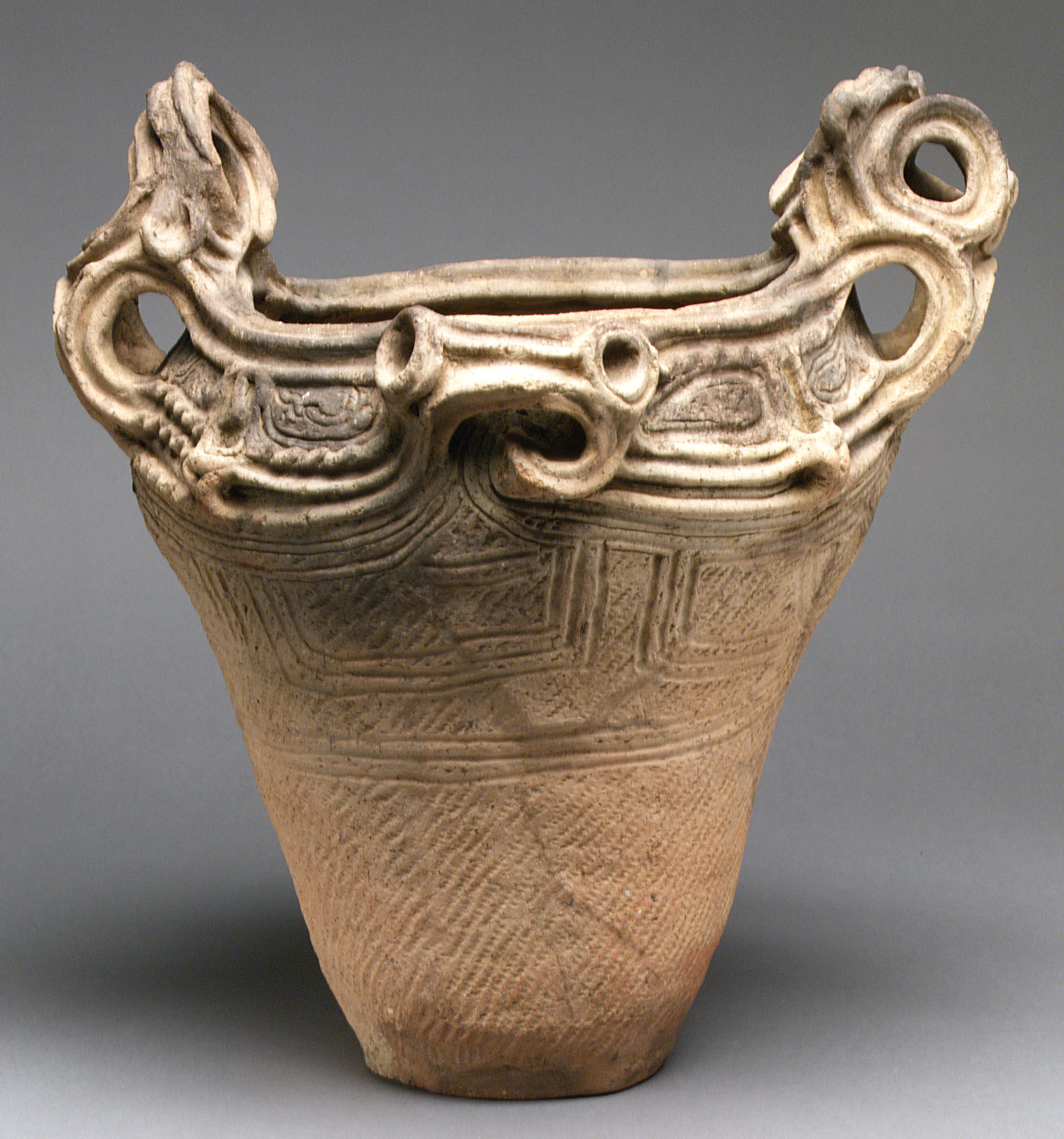The Formative period is separated into three stages: Jomon, Yayoi and Kofun art.
Jomon art
The Jomon people were the first settlers of Japan and lived between the years 11000 - 300BC. Like most people of the Neolithic era, the Jomon people were a hunter and gatherer nomads who eventually settled and began farming and building cities.
The Jomon Period is divided into six periods:
Incipient Jomon from 10500 - 8000BC
Earliest Jomon from 8000 - 5000BC
Early Jomon from 5000 - 2500BC
Middle Jomon from 2500 - 1500BC
Late Jomon from 1500 - 1000BC
Final Jomon from 1000 - 300BC.[2]
The unique patterns on these early pottery were made by pressing rope into the clay before firing. The early pottery of the Incipient Jomon period have pointed bottoms, crude rope markings. indicating that it was mostly used to boil food over a fire. Around the Middle Jomon period, the pottery became more decorative and complex.
Dogu Figurines, "Venus Figure"
second to right [9]
|
From the Middle Jomon period to the Late Jomon period, small humanoid figurines called Dogu were produced prolifically. The earliest known Dogu found is from the Incipient Jomon period. Most Dogu depict pregnant women, an iconic examples is the Jomon Venus figurine, and are typically found broken into pieces. Scholars believe the figurines were used in ceremonious cleansing rituals or as charms used to call upon the gods. Other styles include animal shapes and slit-goggled figurines.[3]
Yayoi art
Yayoi Jar [10]
|
Dotaku Bells[11]
|
The Yayoi period was an Iron Age era named after the area of Tokyo where artifacts were found dating from 300BC to 300AD. A distinguishing characteristic of this period was the new pottery style named Yayoi pottery. The technical process is believed to be the same as Jomon pottery, the coil method, however Yayoi pottery is noticeably smoother and less porous. The pottery also resembles pots found in Korea and it is theorized that the style originated there and traveled throughout norther eastern Japan.[4]
Most weapons, tools and armor were cast from bronze and iron during the Yayoi period, including richly decorated bells called dotaku. It is believed they were used in rituals and as emergency bells to alert residents and warriors of invasion. Dotaku are typically a truncated cone shape with an oval shaped top and is banded with horizontal rows intersected by central vertical rows. The bells have a large arching flange that extends over the top and sides of the body.[5]
decorated in hatched lines, triangles, spirals and geometric patterns.
Kofun art
Daisen Kofun, Sakai, Osaka Prefecture [12]
|
The Konfun period lasted from 250 to 538 AD. It's characterized by burial mounds called kofun, which gave this era its name. Buried around the kofun were unglazed pottery called heiji ware and sue ware, bronze mirrors and figurines called haniwa.[6]
Konfun period pottery is divided into two categories: heiji ware and sue ware. Heiji ware was a utilitarian ware with a redish-yellow color. Sue war was expensive grey ware often used in rituals.[6]
Haniwa Figurines [13]
|
Haniwa were used as grave offerings and came in many different animal forms, objects such as pillows and human figures.[6] Scholars believe they were used as boundary markers for burial mounds and were considered containers for souls. They are often depicted with armor and weapons which may have been intended to "drive-away" evil spirits.
Magatama bead, Final Jomon era [7]
|
The elites from the Yamato court often wore comma-shaped beads called magatama as funerary objects.[6] While magatama can be found as early as the Final Jomon period, they became increasingly popular during the Kofun period. Ealry magatama were made from simple materials such as clay, quartz, and slate. They became more refined and polished during the Yayoi perio
d and were made from gemstones, such as jadedite and seroentinite, and glass. The beads were often made into necklaces, bracelets and anklets and over time became a status symbol for the elite.[7] During the Kofun period, magatama were very common and were buried in almost all kofun. At the height of their popularity, they were made of jadedite, jasper, agate and jade. Some were even capped in silver or gold.[8] Over time they went from decorative jewelry to sacred ceremonial funerary goods. Most haniwa depicted people wearing the beads as necklaces or anklets. Magatama shaped symbols can even be found in modern day Japanese art.
References:
[1] Craig, O.E., Saul, H., Lucquin, A., Nishida, Y., Taché, K., Clarke, L., Thompson, A., Altoft, D.T., Uchiyama, J., Ajimoto, M., Gibbs, K., Isaksson, S., Heron, C.P. and Jordan, P. (2013) ‘Earliest evidence for the use of pottery’, Nature, 496(7445), pp. 351–354. doi: 10.1038/nature12109.
[2] Jomon culture (ca. 10, 500–ca. 300 B.C.) | essay | Heilbrunn Timeline of art history | the metropolitan museum of art (2000) Available at: http://www.metmuseum.org/toah/hd/jomo/hd_jomo.html.
[3] Kawagoe, A. (2007) Jomon Dogu: The mystery of the broken Clay Dolls. Available at: https://heritageofjapan.wordpress.com/just-what-was-so-amazing-about-jomon-japan/ways-of-the-jomon-world-2/jomon-crafts-and-what-they-were-for/the-mystery-of-the-clay-dolls/
[4] Yayoi culture (ca. Fourth century B.C.–Third century A.D.) | essay | Heilbrunn Timeline of art history | the metropolitan museum of art (2000) Available at: http://www.metmuseum.org/toah/hd/yayo/hd_yayo.html
[5] Dōtaku (bronze bell) | work of art | Heilbrunn Timeline of art history | the metropolitan museum of art (2000) Available at: http://www.metmuseum.org/toah/works-of-art/18.68/
[6] Keally, C. (2009) Kofun Culture. Available at: http://www.t-net.ne.jp/~keally/kofun.html
[7] The Pitt Rivers Museum, University of Oxford (no date) Small blessings - Magatama, Japan. Available at: http://web.prm.ox.ac.uk/amulets/index.php/protection-8/
[8] The Editors of Encyclopædia Britannica (1998) ‘Magatama | jade ornament’, in Encyclopædia Britannica. Available at: https://www.britannica.com/art/magatama
[9]Metropolis, W. to F. (no date) Metropolis. Available at: http://metropolisjapan.com/ (Accessed: 23 February 2017).
[10]Boundless (2016) Ceramics and bronze in the Yayoi period. Available at: https://www.boundless.com/art-history/textbooks/boundless-art-history-textbook/japan-before-1333-ce-15/prehistoric-japan-102/ceramics-and-bronze-in-the-yayoi-period-474-6123/ (Accessed: 23 February 2017).
[11] National Museum of Japanese History (2006) The World of Dotaku" (Ceremonial Bronze Bells). Available at: https://www.rekihaku.ac.jp/english/outline/publication/rekihaku/121/witness.html (Accessed: 23 February 2017).
[12]OSAKA CONVENTION & TOURISM BUREAU (no date) Daisenryo Kofun (Emperor Nintoku’s tomb). Available at: http://www.osaka-info.jp/en/facilities/cat17/post_238.html (Accessed: 23 February 2017).
[13]Ningyozuka (no date) Available at: http://archaeology.jp/sites/2007/ningyo.htm (Accessed: 23 February 2017).







